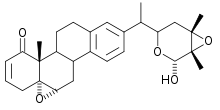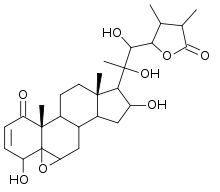Withanolide
Withanolides are a group of at least 300 naturally occurring steroids built on an ergostane skeleton.[1][2] They occur as secondary metabolites primarily in genera of the Nightshade family, for example in the tomatillo.



Structurally, withanolides consist of a steroid backbone bound to a lactone or one of its derivatives; they are produced via oxidation of steroids. It remains unknown to what end withanolides are produced; they may act as a deterrent for feeding insect larvae and other herbivores.
Genera within the nightshade family that produce withanolides include: Acnistus, Datura, Dunalia, Iochroma, Lycium, Nicandra, Physalis, Salpichroa, Solanum, Withania, and Jaborosa.
Examples
Withaferin A, the first withanolide to be isolated, was found in winter cherry (Withania somnifera).
Salpichrolides A, B and G (isolated from Salpichroa origanifolia) exhibit an inhibitory effect on the growth of larva of the Mediterranean fruit fly (Ceratitis capitata). For this reason, potential pesticide uses for the compounds are being explored.[3]
References
- Glotter, E. (1991). "Withanolides and related ergostane-type steroids". Natural Product Reports. 8 (4): 415. doi:10.1039/np9910800415. ISSN 0265-0568. PMID 1787922.
- Kirson, Isaac; Glotter, Erwin (1981). "Recent Developments in Naturally Occurring Ergostane-Type Steroids. A Review". Journal of Natural Products. 44 (6): 633–647. doi:10.1021/np50018a001. ISSN 0163-3864.
- Bado, S.; Mareggiani, G.; Amiano, N.; Burton, G.; Veleiro, A. S. (2004). "Lethal and Sublethal Effects of Withanolides from Salpichroa origanifolia and Analogues on Ceratitis capitata". Journal of Agricultural and Food Chemistry. 52 (10): 2875–2878. doi:10.1021/jf035508a. PMID 15137828.
